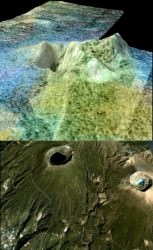Icy volcanoes are likely responsible for changes in brightness on the surface of Titan, the largest moon of Saturn, according to a new study.
Images with the Cassini spacecraft’s visual and infrared mapping spectrometer revealed the brightness, or albedo, of two equatorial areas changing during the study period. Tui Regio (which got darker from 2005 to 2009) and Sotra Patera (which got brighter from 2005 to 2006).
The researchers also pointed to “volcanic-like features” in these areas as evidence that the potential cryovolcanoes, as these icy volcanoes are known, might be connected to an ocean on Titan.

“All of these features, plus a need for a methane reservoir and volcanic activity to replenish the methane in the atmosphere, is compatible with the theory of active cryovolcanism on Titan,” stated Anezina Solomonidou , a planetary geologist with the Paris Observatory as well as the National and Kapodistrian University of Athens.
“These results have important implications for Titan’s potential to support life, as these cryovolcanic areas might contain environments that could harbor conditions favorable for life,” Solomonidou added.
Of note, Titan also has a fresh-looking surface with few craters on it, indicating that something might be altering the surface. “Its landscape is remarkably Earth-like with dunes and lakes, erosion due to weathering and tectonic-like features,” a statement on the research added.
There’s been chatter about cryovolcanoes on Titan before. In 2010, researchers said a chain of peaks found on the moon could be evidence of this type of feature. However, a 2012 preliminary California Institute of Technology weather model of the moon explained many of its features without necessarily needing to rely on cryovolcanoes.
Source: European Planetary Science Congress

